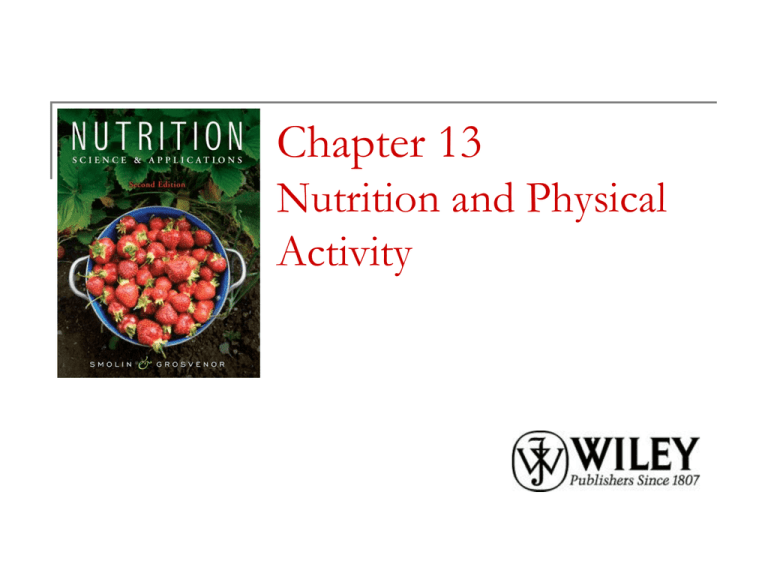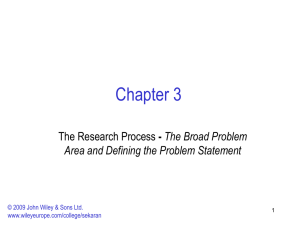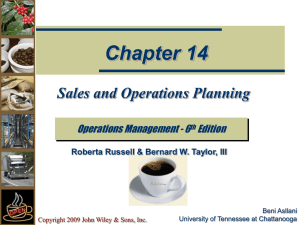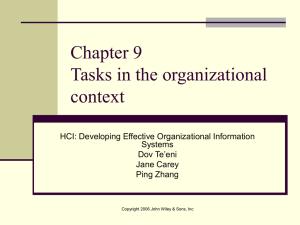
Chapter 13
Nutrition and Physical
Activity
What is fitness?
Fitness is defined as the ability to perform
routine physical activity without undue
fatigue.
Copyright 2010, John Wiley & Sons, Inc.
Exercise, Health and Fitness
The overload principle assumes that the body will
adapt to the stresses placed on it.
Aerobic exercise
includes endurance exercises such as jogging,
swimming or cycling, or any exercise that increases
heart rate and requires oxygen in metabolism.
The cardiorespiratory system
includes the circulatory and respiratory systems,
delivering oxygen and nutrients to the cells.
Copyright 2010, John Wiley & Sons, Inc.
Which is true regarding the overload
principle?
When you exercise, you
should work harder than you
think is possible.
The body will adapt to the
stresses placed on it.
If people exercise too much,
they will not improve fitness.
Overload is to be avoided.
Copyright 2010, John Wiley & Sons, Inc.
Exercise, the Heart and the Muscles
Regular aerobic exercise and the heart
strengthens the heart muscle
increases stroke volume
decreases the resting heart rate.
increases ability of cells to use oxygen to produce energy
increases the circulatory system's ability to deliver oxygen
The resting heart rate can be measured by counting the number of
pulses per minute while at rest.
Aerobic capacity is the body’s maximum ability to generate ATP
by aerobic metabolism during exercise. Aerobic capacity is also
called VO2 max.
Copyright 2010, John Wiley & Sons, Inc.
Which of the following statements about aerobic
capacity is incorrect?
Aerobic capacity is the body's maximum ability to generate ATP by
aerobic metabolism during exercise
Aerobic capacity is dependant on the ability of the
cardiorespiratory system to deliver oxygen to cells.
Aerobic capacity is dependant on the ability of cells to use oxygen
to produce energy.
The smaller a person's aerobic capacity, the more intense activity
can be performed before lack of oxygen affects performance.
Copyright 2010, John Wiley & Sons, Inc.
Excercise and muscle
Stress or overload during exercise causes
muscles to adapt by increasing in size and
strength. This is called hypertrophy.
When muscles are not used, they
atrophy, becoming smaller and weaker.
Copyright 2010, John Wiley & Sons, Inc.
Lifting a heavy weight stresses
muscles causing an adaptation called
a)
hypertrophy
b)
hypotrophy
c)
atrophy
d)
atropic
Copyright 2010, John Wiley & Sons, Inc.
Health Benefits of Exercise
In addition to increased flexibility and the
ability to easily perform daily activities,
benefits of regular exercise include:
Weight management
Cardiovascular health
Diabetes prevention or management
Bone and joint health
Possible reduction of cancer risk
Psychological health
Copyright 2010, John Wiley & Sons, Inc.
The health benefits of exercise
include all of the following except
decrease blood pressure
increase HDL
cholesterol.
decrease the sensitivity
of tissues to insulin.
reduce the risk of
osteoporosis.
Copyright 2010, John Wiley & Sons, Inc.
Exercise Recommendations
Copyright 2010, John Wiley & Sons, Inc.
Todd is 30 years old. If his
target heart rate during aerobic
activity is 60 - 90 % of his
maximum heart rate, how fast
should his heart rate be during
exercise?
a)
b)
c)
d)
60 and 90
114 and 171
132 and 198
160 and 220
Copyright 2010, John Wiley & Sons, Inc.
Target Heart
Rates During
Aerobic
Exercise
Copyright 2010, John Wiley & Sons, Inc.
If Dahlia exercises in such a way as
to expend 300 extra kcalories and
reduces her kcaloric intake by 200
kcalories a day, approximately how
long will it take Dahlia to lose five
pounds?
a)
b)
c)
d)
1 week
15 days
35 days
45 days
Copyright 2010, John Wiley & Sons, Inc.
Which is true regarding maximum heart
rate?
a)
When a person is fit, it takes
less effort to reach his/her
maximum heart rate
b)
Maximum heart rate declines
with age
c)
Maximum heart rate is the
number of times that the heart
beats per minute while a person
it at rest
d)
Maximum heart rate is
calculated using one's weight
and height
Copyright 2010, John Wiley & Sons, Inc.
Components of a Good Exercise
Regimen
Copyright 2010, John Wiley & Sons, Inc.
Fueling Exercise
Aerobic metabolism is metabolism in the presence of
oxygen. Glucose, fatty acids and amino acids are
completely broken down to form CO2 and H20 and to
produce ATP.
Anaerobic metabolism is metabolism in the absence
of oxygen. Each molecule of glucose produces two
molecules of ATP. Glucose is metabolized in this way
when oxygen cannot be supplied quickly enough to the
tissues to support aerobic metabolism.
Anaerobic metabolism is also called anaerobic
glycolysis.
Copyright 2010, John Wiley & Sons, Inc.
Fueling Exercise by the Minute
Copyright 2010, John Wiley & Sons, Inc.
The Process of Anaerobic Metabolism
Copyright 2010, John Wiley & Sons, Inc.
The Effect of Exercise Intensity
Copyright 2010, John Wiley & Sons, Inc.
A major goal of precompetition meals is to
maximize glycogen stores in
the liver
maximize fat stores
maximize activity in the
large intestine
increase caffeine in the
system
Copyright 2010, John Wiley & Sons, Inc.
Nutrient Needs for Physical Activity
Copyright 2010, John Wiley & Sons, Inc.
It is recommended that athletes consume diets
with the following approximate proportions:
PROTEIN 10 - 15% ; FAT < 10%;
CARBOHYDRATE 70 - 80%
PROTEIN 10 - 20%; FAT < 30%;
CARBOHYDRATE 55 - 60%
PROTEIN 15 - 22%; FAT < 15%;
CARBOHYDRATE 60 - 70%
PROTEIN 12 - 17%; FAT 2 - 5 %;
CARBOHYDRATE 80 - 90 %
Copyright 2010, John Wiley & Sons, Inc.
Relationship of Exercise to Intake
The source of dietary energy can be as important
as the amount of energy in an athlete’s diet.
The general proportion of energy for athletes and
healthy individuals should be:
45-65% total energy from carbohydrates
20-35% from fat
10-35% from protein
Copyright 2010, John Wiley & Sons, Inc.
Vitamins and minerals requiring
special attention from athletes:
B vitamins
Antioxidant vitamins, such as vitamins C and E
Iron
Sports anemia (blood volume expands to increase oxygen
delivery, but the synthesis of Red Blood Cells lags behind._
Calcium
Female athlete triad
Too much exercise combined with limited food intake can
lead to hormonal abnormalities
Copyright 2010, John Wiley & Sons, Inc.
Over-exercise, Under-nutrition
Low energy intakes and excessive exercise
in female athletes may result in low levels of
the hormone, estrogen that in turn contributes
to reductions in bone mineral density
Amenorrhea has the greatest effect on which
mineral in a female athlete's body?
a) calcium
b) fluoride
c) iron
D) magnesium
Copyright 2010, John Wiley & Sons, Inc.
Fluid Needs for Physical Activity
During exercise, water is needed to eliminate heat, to
transport oxygen and nutrients to the muscles and to remove
waste products such as lactic acid from the muscles.
The ability to dissipate heat depends on hydration levels.
At rest in a temperate climate, an adult loses about 4½ cups
of water per day through evaporation from the skin and
lungs.
Even with regular consumption, it may not be possible to
consume sufficient fluid to remain properly hydrated.
Failure to compensate for fluid losses can result in
dehydration.
If heat cannot be lost from the body, body temperature rises
and exercise performance as well as health can be
jeopardized.
Copyright 2010, John Wiley & Sons, Inc.
Fluid Needs for Physical Activity
Dehydration occurs when water loss is great enough for
blood volume to decrease.
Dehydration reduces the body’s ability to deliver oxygen
and nutrients to muscles.
Copyright 2010, John Wiley & Sons, Inc.
During hot weather, athletes
should consume fluids
___________ exercise.
a)
b)
c)
d)
before
during
after
All answer choices
are correct.
Copyright 2010, John Wiley & Sons, Inc.
dehydration
Kids and the elderly are much more prone to
dehydration… why?
Kids produce more heat
Kids are less efficient at transferring heat
from muscle to skin
Kids take longer to acclimatize to heat
Kids sweat less than adults
Copyright 2010, John Wiley & Sons, Inc.
Hyponatremia : abnormally low sodium in the
blood
Copyright 2010, John Wiley & Sons, Inc.
Sports drinks
What should you drink during a long
workout?
Beverages containing a small amount of
carbohydrate (15-20 grams or 6-8%)
Empty rapidly from the stomach
Enhance intestinal absorption
Facilitate water retention
500-700 mg sodium/liter for exercise lasting over
an hour
Copyright 2010, John Wiley & Sons, Inc.
Regarding weight loss in athletes, which is the false
statement?
Weight loss of no more than 2 pounds a week is
recommended.
Losing weight during the “off” season is usually a
better idea than losing weight while training and
competing.
Fluid can be safely restricted if energy is also
restricted when quick weight loss is desired.
Severe calorie restriction in young female athletes
can delay sexual maturation
Copyright 2010, John Wiley & Sons, Inc.
Heat-Related Illnesses
Copyright 2010, John Wiley & Sons, Inc.
Cold and dehydration
Dehydration may be a concern in the
cold.. Why?
Cold air is drier so more evaporative losses
from the lungs
Insulated clothing causes sweating
Athletes may be reluctant to drink cold
beverages when its cold
May limit intake to avoid removing clothing in
order to urinate
Copyright 2010, John Wiley & Sons, Inc.
Heat related illness is characterized by
all of the following except:
a)
decreased blood volume
b)
increased blood pressure
c)
rise in core body
temperature
d)
reduced sweat production
Copyright 2010, John Wiley & Sons, Inc.
As an athlete…
How much should you drink?
Copyright 2010, John Wiley & Sons, Inc.
Recommended Fluid Intake
Copyright 2010, John Wiley & Sons, Inc.
32 oz in 1 liter
8 oz in 1 cup
~4 cups in 1
liter
Copyright 2010, John Wiley & Sons, Inc.
Food and Beverages to Maximize
Performance
Copyright 2010, John Wiley & Sons, Inc.
What Are You
Getting From
That Sports
Bar?
Copyright 2010, John Wiley & Sons, Inc.
Evaluating the Benefits and Risks of
Ergogenic Supplements
Copyright 2010, John Wiley & Sons, Inc.
Claims, Benefits and Risks of Popular
Ergogenic Aids
Copyright 2010, John Wiley & Sons, Inc.
Claims, Benefits and Risks of Popular
Ergogenic Aids
Copyright 2010, John Wiley & Sons, Inc.
Caffeine
Copyright 2010, John Wiley & Sons, Inc.
Impact of Diet versus Supplements
Copyright 2010, John Wiley & Sons, Inc.
Chapter 13
Copyright 2010 John Wiley & Sons, Inc.
All rights reserved. Reproduction or translation of this work beyond
that permitted in section 117 of the 1976 United States Copyright Act
without express permission of the copyright owner is unlawful.
Request for further information should
be addressed to the
.
Permissions Department, John Wiley & Sons, Inc. The purchaser may
make back-up copies for his/her own use only and not for distribution
or resale. The Publisher assumes no responsibility for errors,
omissions, or damages caused by the use of these programs or from
the use of the information herein.
Copyright 2010, John Wiley & Sons, Inc.










